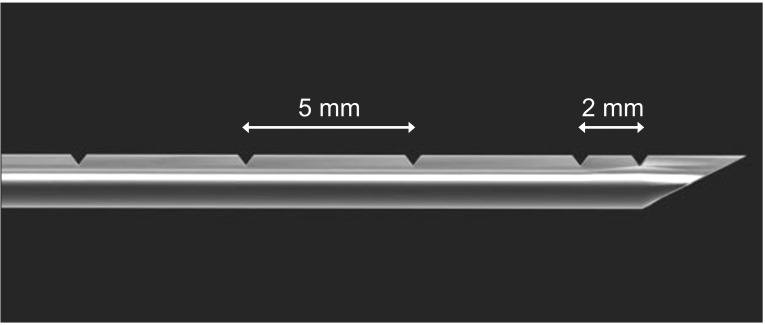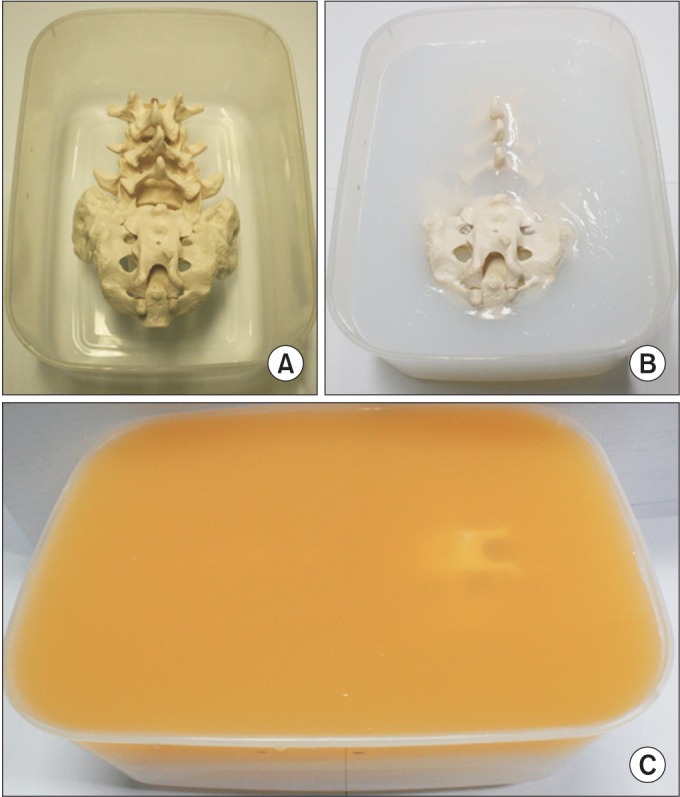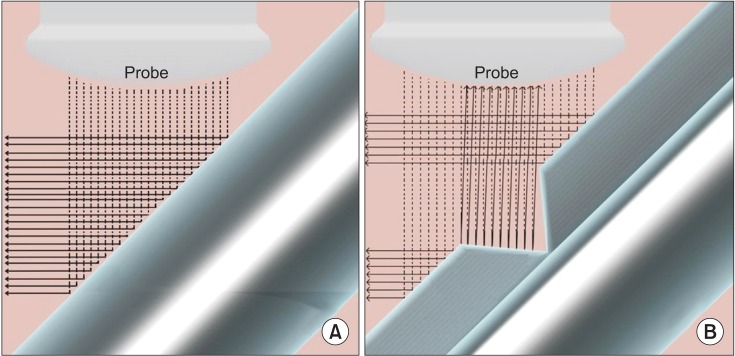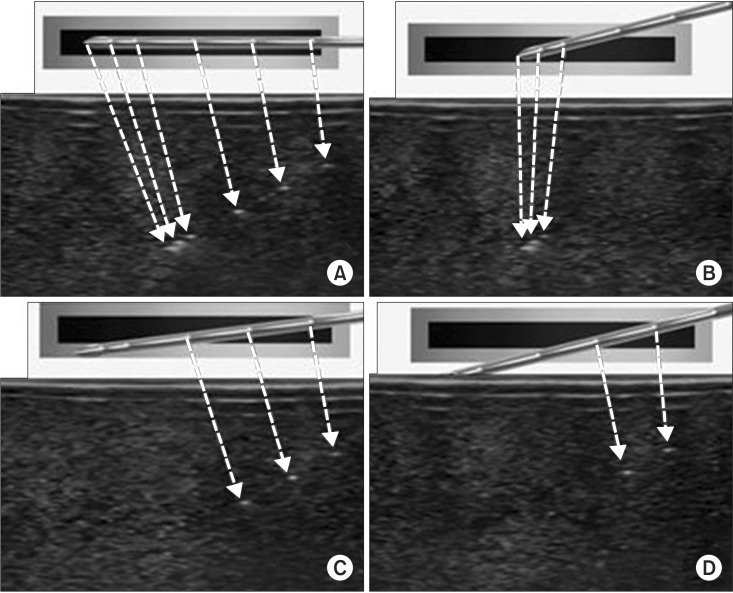1. Greher M, Scharbert G, Kamolz LP, Beck H, Gustorff B, Kirchmair L, et al. Ultrasound-guided lumbar facet nerve block: a sonoanatomic study of a new methodologic approach. Anesthesiology. 2004; 100:1242–1248. PMID:
15114223.
2. Saal JS. General principles of diagnostic testing as related to painful lumbar spine disorders: a critical appraisal of current diagnostic techniques. Spine (Phila Pa 1976). 2002; 27:2538–2545. PMID:
12435989.
3. Ha DH, Shim DM, Kim TK, Kim YM, Choi SS. Comparison of ultrasonography- and fluoroscopy-guided facet joint block in the lumbar spine. Asian Spine J. 2010; 4:15–22. PMID:
20622950.

4. Kaplan M, Dreyfuss P, Halbrook B, Bogduk N. The ability of lumbar medial branch blocks to anesthetize the zygapophysial joint: a physiologic challenge. Spine (Phila Pa 1976). 1998; 23:1847–1852. PMID:
9762741.
5. Chin KJ, Perlas A, Chan VW, Brull R. Needle visualization in ultrasound-guided regional anesthesia: challenges and solutions. Reg Anesth Pain Med. 2008; 33:532–544. PMID:
19258968.

6. Crum T, Adhikari S, Lander L, Blaivas M. Do echo-enhanced needles make a difference in sonographically guided vascular access? J Ultrasound Med. 2014; 33:623–628. PMID:
24658941.

7. Kilicaslan A, Topal A, Tavlan A, Erol A, Otelcioglu S. Differences in tip visibility and nerve block parameters between two echogenic needles during a simulation study with inexperienced anesthesia trainees. J Anesth. 2014; 28:460–462. PMID:
24127134.

8. Marks R, Semple AJ. Spinal anaesthesia after facet joint injection. Anaesthesia. 1988; 43:65–66. PMID:
3344957.

9. Sites BD, Spence BC, Gallagher JD, Wiley CW, Bertrand ML, Blike GT. Characterizing novice behavior associated with learning ultrasound-guided peripheral regional anesthesia. Reg Anesth Pain Med. 2007; 32:107–115. PMID:
17350520.

10. Gottlieb RH, Robinette WB, Rubens DJ, Hartley DF, Fultz PJ, Violante MR. Coating agent permits improved visualization of biopsy needles during sonography. AJR Am J Roentgenol. 1998; 171:1301–1302. PMID:
9798867.

11. Culp WC, McCowan TC, Goertzen TC, Habbe TG, Hummel MM, LeVeen RF, et al. Relative ultrasonographic echogenicity of standard, dimpled, and polymeric-coated needles. J Vasc Interv Radiol. 2000; 11:351–358. PMID:
10735431.

12. Barr RG. Improved needle visualization with electronic beam steering: proof of concept. Ultrasound Q. 2012; 28:59–64. PMID:
22634767.
13. Hocking G, Mitchell CH. Optimizing the safety and practice of ultrasound-guided regional anesthesia: the role of echogenic technology. Curr Opin Anaesthesiol. 2012; 25:603–609. PMID:
22825047.
14. Edgcombe H, Hocking G. Sonographic identification of needle tip by specialists and novices: a blinded comparison of 5 regional block needles in fresh human cadavers. Reg Anesth Pain Med. 2010; 35:207–211. PMID:
20301826.
15. Uppal V, Sondekoppam RV, Ganapathy S. Effect of beam steering on the visibility of echogenic and non-echogenic needles: a laboratory study. Can J Anaesth. 2014; 61:909–915. PMID:
25053210.

16. Bellingham GA, Peng PW. A low-cost ultrasound phantom of the lumbosacral spine. Reg Anesth Pain Med. 2010; 35:290–293. PMID:
20921841.

17. Kendall JL, Faragher JP. Ultrasound-guided central venous access: a homemade phantom for simulation. CJEM. 2007; 9:371–373. PMID:
17935654.

18. Greher M, Kirchmair L, Enna B, Kovacs P, Gustorff B, Kapral S, et al. Ultrasound-guided lumbar facet nerve block: accuracy of a new technique confirmed by computed tomography. Anesthesiology. 2004; 101:1195–1200. PMID:
15505456.
19. Guo S, Schwab A, McLeod G, Corner G, Cochran S, Eisma R, et al. Echogenic regional anaesthesia needles: a comparison study in Thiel cadavers. Ultrasound Med Biol. 2012; 38:702–707. PMID:
22390992.

20. Rauch S, Kasuya Y, Turan A, Neamtu A, Vinayakan A, Sessler DI. Ultrasound-guided lumbar medial branch block in obese patients: a fluoroscopically confirmed clinical feasibility study. Reg Anesth Pain Med. 2009; 34:340–342. PMID:
19585701.
21. Miura M, Takeyama K, Suzuki T. Visibility of ultrasound-guided echogenic needle and its potential in clinical delivery of regional anesthesia. Tokai J Exp Clin Med. 2014; 39:80–86. PMID:
25027252.
22. Sviggum HP, Ahn K, Dilger JA, Smith HM. Needle echogenicity in sonographically guided regional anesthesia: blinded comparison of 4 enhanced needles and validation of visual criteria for evaluation. J Ultrasound Med. 2013; 32:143–148. PMID:
23269719.
23. Gofeld M, Krashin DL, Ahn S. Needle echogenicity in ultrasound-guided lumbar spine injections: a cadaveric study. Pain Physician. 2013; 16:E725–E730. PMID:
24284853.
24. Deam RK, Kluger R, Barrington MJ, McCutcheon CA. Investigation of a new echogenic needle for use with ultrasound peripheral nerve blocks. Anaesth Intensive Care. 2007; 35:582–586. PMID:
18020079.

25. Maecken T, Zenz M, Grau T. Ultrasound characteristics of needles for regional anesthesia. Reg Anesth Pain Med. 2007; 32:440–447. PMID:
17961844.

26. Schafhalter-Zoppoth I, McCulloch CE, Gray AT. Ultrasound visibility of needles used for regional nerve block: an in vitro study. Reg Anesth Pain Med. 2004; 29:480–488. PMID:
15372394.
27. Nichols K, Wright LB, Spencer T, Culp WC. Changes in ultrasonographic echogenicity and visibility of needles with changes in angles of insonation. J Vasc Interv Radiol. 2003; 14:1553–1557. PMID:
14654490.

28. Hebard S, Hocking G. Echogenic technology can improve needle visibility during ultrasound-guided regional anesthesia. Reg Anesth Pain Med. 2011; 36:185–189. PMID:
21425515.

29. Chapman GA, Johnson D, Bodenham AR. Visualisation of needle position using ultrasonography. Anaesthesia. 2006; 61:148–158. PMID:
16430568.






 PDF
PDF ePub
ePub Citation
Citation Print
Print









 XML Download
XML Download